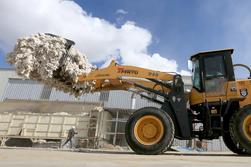 A loader moves seed cotton at a cotton ginning mill in Bachu county, Xinjiang Uygur autonomous region, in April, 2021. (CAI ZENGLE / FOR CHINA DAILY)
A loader moves seed cotton at a cotton ginning mill in Bachu county, Xinjiang Uygur autonomous region, in April, 2021. (CAI ZENGLE / FOR CHINA DAILY)
China will strengthen cooperation in the cotton industry with countries participating in the Belt and Road Initiative during the 14th Five-Year Plan (2021-25) to reduce reliance on imported cotton from the United States and Australia, a senior academic with the Chinese Academy of Agricultural Sciences said recently.
Li Fuguang, head of the academy's Institute of Cotton Research, said Central Asia's great potential in cotton production will help meet import demand of 2 million metric tons based on China's clothing textile needs and cotton production.
"Taking advantage of complementary countries in Central Asia will be conducive to a strong response to the trade conflicts between China and the US, and meanwhile promote implementation of the Belt and Road Initiative," Li said.
Cotton production in Central Asia covers nearly 2 million hectares, and the environment there is similar to the Xinjiang Uygur autonomous region, which accounts for 84.9 percent of cotton production in China.
ALSO READ: Xinjiang's cotton production facilitate poverty relief
If the cotton-making technology in Xinjiang is applied to Central Asian countries, the production in the region will see rapid development.
Li Fuguang, head of Chinese Academy of Agricultural Sciences' Institute of Cotton Research
"If the cotton-making technology in Xinjiang is applied to Central Asian countries, the production in the region will see rapid development," Li said, adding that production is expected to increase by at least 5 percent.
Demonstration technology parks have been established in Uzbekistan since 2018 to promote Chinese cotton-growing technologies. Demand for irrigation water has dropped by two-thirds while yields have doubled, Li said.
In the following five years, China will focus on introducing the cotton cultivation technology to Uzbekistan, and keep advancing it in Tajikistan and Kyrgyzstan, he added.
It will also beef up efforts to realize the modernization of the cotton industry by upgrading systems and innovating key technologies.
The country plans to strengthen the collection and utilization of cotton germplasm resources, explore excellent gene sources, and create excellent resources with high yield, good quality and wide adaptability, the academy said.
China will develop environment-friendly and sustainable cotton planting technology to improve productivity and benefits, increase farmers' incomes and contribute to rural vitalization, Li said.
The China Cotton Industry Alliance, a nonprofit organization led by the institute, will play a major role in improving cotton quality and integrating the entire industry chain.
The alliance issued a statement late last month resolutely opposing any stigmatization of Xinjiang cotton. It is endeavoring to build a high-quality cotton industry chain and increase international recognition of domestic cotton brands.
During the 13th Five-Year Plan (2016-20) period, China stabilized its cotton planting area at about 3.3 million hectares, the academy said.
"The country's cotton production has maintained an annual output of 6 million tons, and it ensures our cotton security," Li said.
READ MORE: Ban on Xinjiang cotton called anti-China ploy
Contact the writer at zhaoyimeng@chinadaily.com.cn


